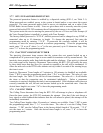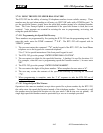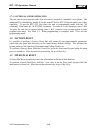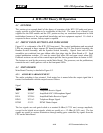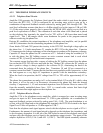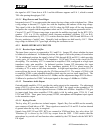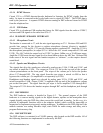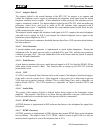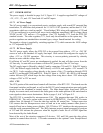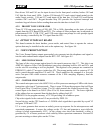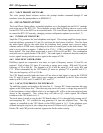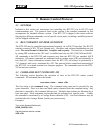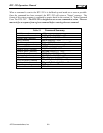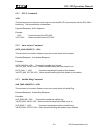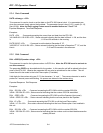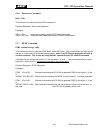
RTU-292 Operations Manual
4.3.7 POWER SUPPLY
The power supply is detailed in page 8 of 9, Figure 8-2. It supplies regulated DC voltages of
+5V, +12V, -5V, and -12V from both AC and DC inputs.
4.3.7.1 AC Power Supply
The AC power supply is a conventional passive regulator supply with a small PC mounted line
transformer, T4 which has dual primaries for 115 or 230 VAC operation, and has dual 15 VAC
secondaries which are wired in parallel. T4 and bridge CR36 along with capacitors C120 and
C121 are configured as a positive full wave circuit supplying unregulated +BUS voltage (about
20VDC) to the +12V and two +5V regulators. One +5V regulator, U72, feeds the RTU-292
standard circuits. The other regulator, U71, feeds only the assemblies on the option tray. The
positive regulators are standard three-terminal types, using a finned heatsink for cooling.
The negative voltage is supplied by switching regulator U73, which converts the +BUS voltage
to -12V adjustable by R212.
4.3.7.2 DC Power Supply
The DC power supply allows the RTU-292 to be powered from either a +12V or +24V DC
source as well as the standard AC supply line input. Slide switch S6 configures the supply for
either +12V or +24/28V operation. This circuitry is reverse-polarity protected by schottky
diodes in series with the voltage lines.
If sufficient AC and DC power are simultaneously applied, the unit will draw power from the
AC line only. Its auto take-over feature will draw DC power only if the AC line sags.
The DC supply input is filtered by choke L2 and by capacitors C50 and C51. If the DC input is
+12V, this filtered supply feeds the +BUS directly via CR34, and supplies +12V around U70
via CR33. It also supplies voltage directly to the inputs of the +5V regulators through CR39
and R213, and through CR40 and R214. If the DC input is +24/28V, the +BUS is fed through
emitter follower Q24, which keeps the bus voltage from rising above about +24V when input
voltages of 24V to 32V are used.
4.3.8 CPU
The CPU portion of the main board controls all functions of the RTU-292. This board uses the
front panel switches and keypad, as well as the RS-232 serial communications port and signals
received over the telephone as control inputs. The Main board lights front panel LEDs to
display its current status, and controls the audio gates on the audio portion of the main board to
route signals to their correct destinations. Refer to pages 5, 6 & 7 of Figure 8-2.
The RTU-292 is controlled by microprocessor U46. The program that runs U46 resides in
EPROM U40. The unit’s current status is stored in EEPROM U41. Octal latch U39 creates
address lines A0 through A7 from the data bus and the AS control line. Voltage supervisor
U45 ensures that the microprocessor turns off and on in an orderly manner when power is
turned off and on or during power glitches. RS-232 driver U37 interfaces the microprocessor
with the serial communications port. The /IRQ (interrupt request) signal generated by portions
of U47 and U48 informs the processor when the keypad is under use or a DTMF signal has
been detected by the Audio Board.
Most of the rest of the circuitry comprises I/O devices. U43 and U44 create the chip selects
required to control these devices. U38 sends commands to the optional Voice Prompt Board.
JPS Communications, Inc.
4-24



